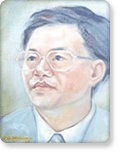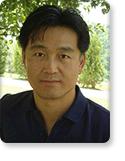
Plenary Speakers
 |
Professor Jong-Hwan Kim Biography KAIST Korea URL: http://rit.kaist.ac.kr “The Next Technological Wave: Intelligence Technology (“IT”) for Intelligence Super-Agent”Information technology (IT), first coined in 1958 and booming since the early 1990s, is the application of computers and telecommunication equipments to store, retrieve, transmit and manipulate data. In 1990s, the concept of Information Superhighway was developed to realize the goals of IT across the globe. In a business context, it has been defined as "the study, design, development, application, implementation, support or management of computer-based information systems" by the Information Technology Association of America. It has generated several associated industries, such as computer HW, SW, electronics, semiconductors, internet, telecom equipment, e-commerce and computer services. Now we are facing a new technological challenge on how to store and retrieve knowledge and manipulate intelligence, in addition to the management of information and data, for autonomous services by intelligent systems. In this regard, the speaker has proposed “intelligence technology (“IT”) for robots that think” in his recent paper in IEEE Computational Intelligence Magazine (August 2013). “IT” is the application of computers and machines to perceive and process data and information for knowledge-based reasoning and utilize their own reasoning to execute an appropriate action. “IT” covers all aspects of intelligence from perception at sensor level and reasoning at cognitive level to behavior planning at execution level for each low level segment of the machine. It is equipped with technologies for cognitive reasoning, social interaction with humans, behavior planning, ability to cooperate with other robots, ambience awareness, and an artificial genome that can be passed on to other robots. Based on these six aspects of intelligence technology, “IT” can be employed to build “Intelligence Super-Agent (iSA).” A virtual example for such an agent is VIKI (Virtual Interactive Kinetic Intelligence), an intelligent virtual super-agent from a science-fiction action film, I-Robot, released in 2004. iSA aims to augment human capabilities in perception, reasoning and actions as well as to provide intelligent supervision to lesser intelligent robots and devices within its domain This talk presents the concept of iSA and Intelligence Operating Architecture (iOA) for realizing iSA using “IT.” iOA, inspired by human brain functions, is a modular framework that can be used as a whole or in modules to generate intelligent functions for iSA. It can be used to implement different kinds of intelligence, such as cognitive intelligence, social intelligence, behavioural intelligence, ambient intelligence, collective intelligence and genetic intelligence. To emphasize the functionality of each category of intelligence, this talk also introduces the related research outcomes for building thinking robots, i.e. “Robots That Think,” carried out at the Robot Intelligence Technology Lab., KAIST in recent years. These research outcomes include mechanisms of thought for robots, humanoid robot’s ability to choose the gaze direction, evolutionary multi-objective optimization for humanoid robot navigation, etc. Moreover, DREAM (Development of Robots Enacted through user-level Agent-based Modularization) for realising iSA and other intelligent robots through iOA are also presented. These outcomes shall pave the way to the development of iSA. Related publications are available at http://rit.kaist.ac.kr/home/International_Journal. |
 |
Professor Tetsuya Iwasaki Biography University of California, Los Angeles USA URL: www.seas.ucla.edu/~iwasaki “Dynamics and Control of Oscillatory Movements in Animal Locomotion”Oscillations are often observed in nature at multiple levels, and form a basis for sustained operation of various functionalities. This talk introduces biological principles for coordinated oscillations and provides an overview of some recent developments on the analysis and design of dynamical mechanisms for oscillations, inspired by neuronal control systems. A particular focus will be placed on rhythmic body movements observed in animal locomotion, controlled by neuronal circuits called central pattern generators (CPGs). Biological mechanisms for locomotion will be mathematically formalized by viewing rhythmic movements as a limit cycle resulting from dynamic interactions of a CPG, body, and environment. We then discuss a neuronal pattern formation problem, where it is examined how the neural interconnection structure within a CPG relates to the profile of oscillation. It is shown that the frequency and amplitude are encoded in the maximal eigenvalue of the interconnection matrix, and the phase pattern is encoded in the corresponding eigenvector. A biomechanical pattern formation problem is also discussed, where an optimal periodic body motion (or gait) is sought to minimize a quadratic cost function such as mechanical power consumption, while maintaining a prescribed locomotion velocity. The analysis and design methods are illustrated by undulatory swimming of slender fish and flapping propulsion of batoids. The results form a basis for a fundamental theory of feedback control for coordinated oscillations, which has broad areas of potential applications, including periodic movements of robotic manipulators, autonomous vehicles inspired by animal locomotion, multi-vehicle motion coordination, phase synchronization of power systems, treatments for neurological disorders, and neuromechanical prosthetic devices. |
 |
Professor Alan Mackworth Biography University of British Columbia Canada URL: www.cs.ubc.ca/~mack/ “Designing Constraint-Based Robots”In order to thrive, a robot must satisfy dynamic constraints deriving from four sources: its internal structure, its goals and preferences, its external environment and the coupling between its internal and external worlds. The life of any robotic agent who acts without respecting those constraints will be out of balance. Based on this framework, I shall give four perspectives on the theme of designing constraint-based agents. The first is a discussion of the evolution of the concept of constraints in intelligent systems, from static to dynamic constraints. Second, I shall present our theory of constraint-based agent design and a corresponding experiment in robot architecture. Third, I shall sketch our work on the design and testing of a semi-autonomous wheelchair for people with physical and mental disabilities, who are living with significant additional constraints. Finally, our collective failure to recognize and satisfy various constraints explains why many of the multiple worlds we live in are so out of kilter. This approach suggests ways of restoring the balance. |









